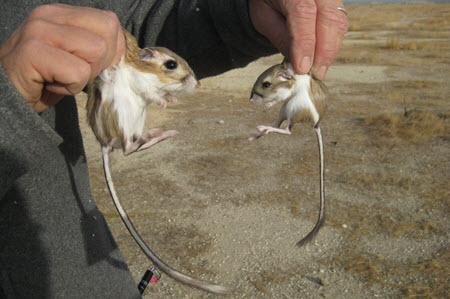
With more than 14,000 acres of habitat supporting hundreds of animal and plant species, there is no such thing as a “typical day” on Bitter Creek National Wildlife Refuge in southwestern Kern County. Still, some days stand out more than others, such as Sept. 30, 2016, when a giant kangaroo rat was discovered on the refuge.
“It’s nice to get the documentation that it’s on the refuge,” said Stanislaus State research technician Larry Saslaw, who set the live trap that caught the giant kangaroo rat. Saslaw, is a retired wildlife biologist with the Bureau of Land Management who now works part-time for the Endangered Species Recovery Program (ESRP), a research program that was established 25 years ago at Stanislaus State.
Saslaw was assisted in this project by principal investigator Dr. Brian Cypher, who is the Associate Director and Research Ecologist for the ESRP and by Stan State wildlife biologist Tory Westall.
Bitter Creek established the partnership with the University three years ago to enhance the small mammal monitoring efforts on the refuge. The ESRP helped Bitter Creek set up its monitoring program and is actively working with refuge staff to build capacity.
ESRP was first established in July 1992 by Dr. Dan Williams with support from the US Fish and Wildlife Service and the Bureau of Reclamation. It continues to be a vital partnership, according to Paul Souza, the service’s Pacific Southwest Regional Director. “This collaboration demonstrates the power of conservation partnerships, which is a priority for the service,” Souza said. “Both of our programs are benefitting from the close coordination and our shared goal to ensure that threatened and endangered species have suitable habitat where they can thrive.”
The presence of giant kangaroo rats and other small animals on the refuge is an indication of a healthy ecosystem. The northwestern portion of the refuge borders the Carrizo Plain National Monument and it is not uncommon for species from the Carrizo Plain to cross over into Bitter Creek. In fact, there are occasional sightings of San Joaquin kit fox and pronghorn (i.e., American antelope)—but the September capture of the giant kangaroo rat marks the first-ever sighting of the species on Bitter Creek.
“I think it’s important because it demonstrates that our goals for Bitter Creek are achievable,” said Michael Brady, Project Leader for Hopper Mountain Refuge Complex. The habitat enhancements target giant kangaroo rat and San Joaquin kit fox populations, providing an area outside the Carrizo Plain that offers suitable habitat. “We’re very proud of the work that we’ve done since the conservation plan was completed and the partnerships we’ve developed,” Brady said. “We’re looking to do more for these species in the future.”
The giant kangaroo rat has been federally listed as endangered since 1987. In 1998, and with major involvement by the Endangered Species Recovery Program, the Service published a ground-breaking recovery plan that laid out recovery strategies for the giant kangaroo rat and 33 other species in the San Joaquin Valley.
While there have not been any sightings of the giant kangaroo rat since September, Brady explained that, “it was probably moving through looking for a home, but we’re looking for evidence to determine whether or not the species has colonized the refuge yet and made it a permanent home.” Nevertheless, he seems confident that both the giant kangaroo rat and San Joaquin kit fox will either become regular visitors or make Bitter Creek their new home in the near future.